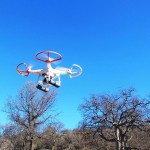I recently had the opportunity to speak with Jerry Robinson, a Missouri-based crop dusting pilot who has been an early innovator in the use of drones for agriculture. I asked him about the uses of drones in agriculture and his thoughts on recent FAA attempts to regulate commercial use of drones.
Daniel Riley: Hello Mr. Robinson, Please introduce yourself and the work you do.
Jerry Robinson: My name is Jerry Robinson. I live in Missouri and am a retired crop-dusting pilot and model aviation enthusiast. I have been in the crop dusting industry since I got my commercial pilots license at age 23. Throughout my entire life I have been building and flying radio controlled aircraft as a hobby.
Daniel: Describe your work with drones.
Jerry: In 2009, I began attaching cameras to my R/C aircraft just to see how the images would turn out. I quickly realized the possibilities of using UAVs for aerial imaging and began using my planes to monitor crops. This was much more cost effective than employing full-scale aircraft. At this time, I started a small aerial photography business on the side, doing mostly real-estate photography.
Daniel: Did you ever get paid for using drones commercially?
Jerry: Yes. As stated above, I did aerial photography for real-estate clients and crop monitoring. I received pay for the agricultural work as well. At the time, my crop-dusting company did quite a bit of field monitoring work and I was able to take a good portion of these jobs with my model aircraft.
Daniel: Were you or your company ever contacted by the FAA about receiving compensation flying drones?
Jerry: No. This was before all the FAA mumbo jumbo began. The so-called ‘drone’ I was flying was no different than the model airplanes I had been building and flying for over 50 years.
Daniel: How were the images you took used by farmers?
Jerry: Mainly for determining which sections of the fields are not getting enough water. Aerial photos can also help find sections of the field that are nutrient deprived or need fertilizer. These days, drones are carrying infrared cameras to determine whether plants are absorbing or reflecting light differently. This is an indication that the plants are diseased or nutrient deficient.
Daniel: Are there any other benefits to using drones over full-scale aircraft besides the reduced cost?
Jerry: No, but the cost saving makes it worth it. Manned aircraft are capable of staying in the air much longer and this makes it easier to get the right shot. Also manned aircraft can fly much higher to cover more ground area.
Daniel: What are your views on the FAA and how they have been dealing with UAVs?
Jerry: The FAA has been great up until the recent personal drone craze. I do, however, sympathize with them, as I understand regulating small aircraft is no easy task. They do need to realize a 5lb foam airplane should be treated differently than a 60lb fiberglass drone.
Daniel: Thank you for your time.


